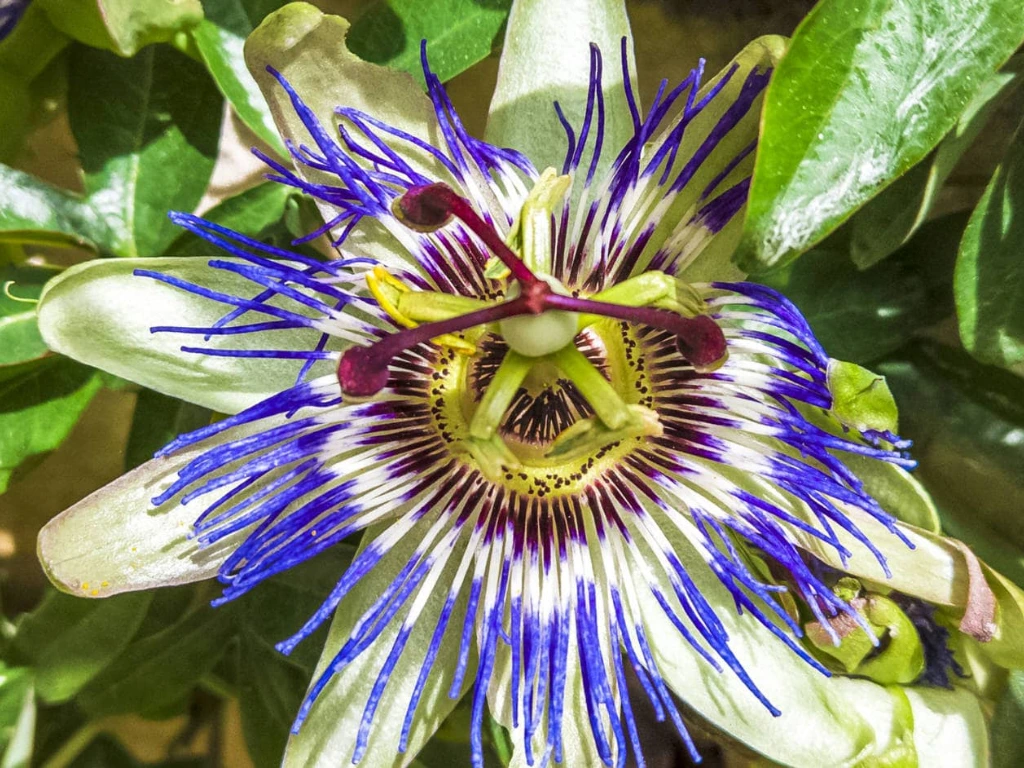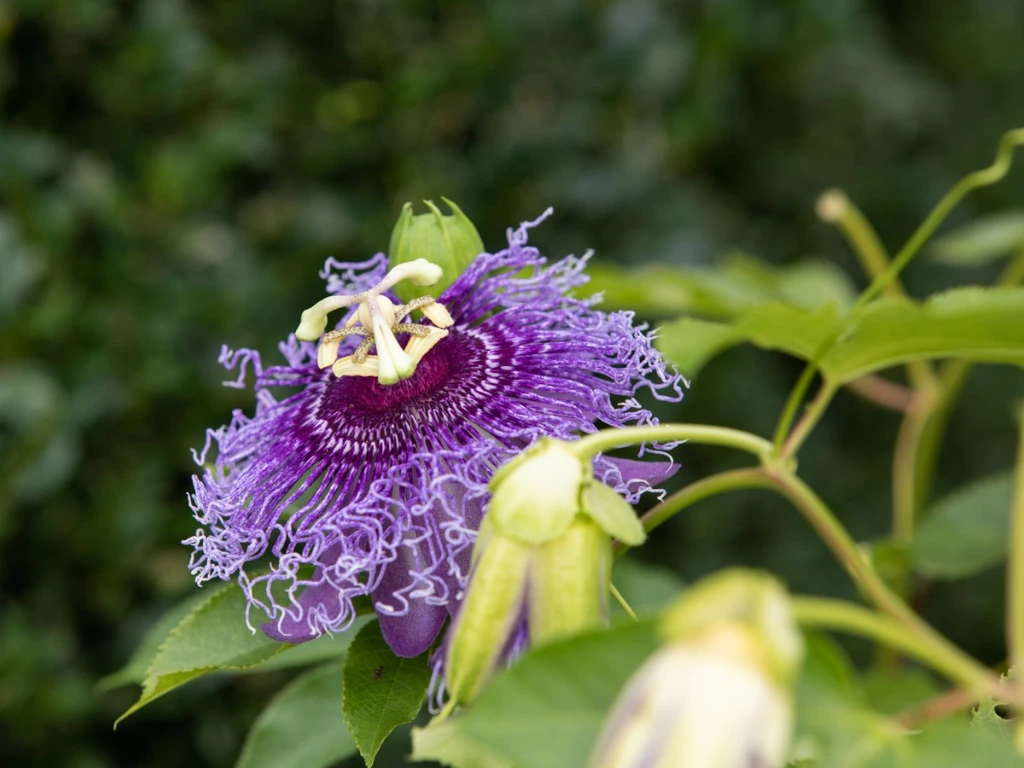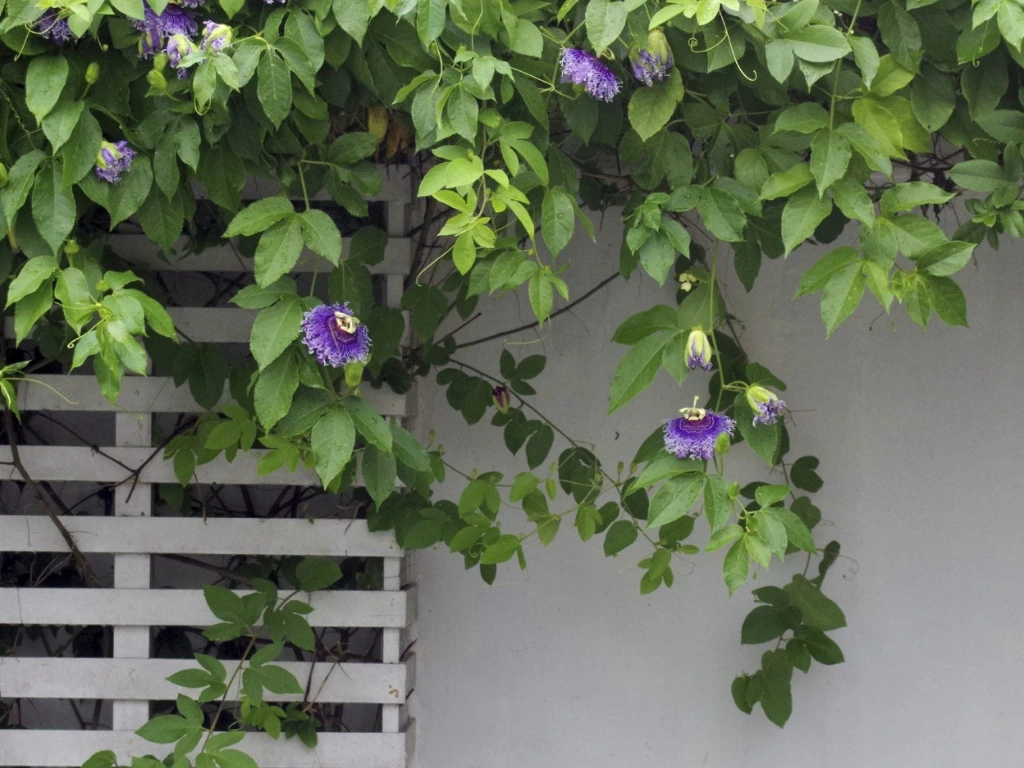Passionflowers are truly a sight to behold, blooming from midsummer to early fall, usually between July and September. Each delicate flower lasts just a day, but during its brief time, it captivates with its vibrant colors and intricate design. The blooms range from 1 to 6 inches in diameter, featuring unique petals with wavy fringes at the center. These fragrant flowers come in stunning shades of purple, or in beautiful combinations of pink and white.
Are you struggling with getting your passionflower to bloom? You’re not alone. Many gardeners face this challenge, especially when trying to grow this beautiful, exotic vine. But don’t worry!
In this guide, we’ll dive deep into the steps to encourage your passionflower to bloom, from understanding the plant’s needs to solving common issues. Let’s explore how you can enjoy vibrant passionflower blooms in your garden or indoors.
Understanding Passionflower Varieties
There are several varieties, but the two most common ones are Passiflora caerulea (blue passionflower) and Passiflora incarnata (purple passionflower). Each variety may have slightly different blooming requirements, so understanding your plant’s specific needs can help you get the best results.
Passiflora Caerulea (Blue Passionflower)

-
Known for its striking blue and white flowers, Passiflora caerulea thrives in full sunlight and requires a warm, temperate climate.
-
It’s more tolerant of cooler temperatures compared to other passionflower species.
Passiflora Incarnata (Purple Passionflower)

-
This variety is more resilient in slightly cooler conditions, making it ideal for areas with milder climates.
-
It produces beautiful purple flowers and is often used for its medicinal properties.
Essential Conditions for Blooming
To get your passionflower to bloom, creating the right environment is crucial. Here are the most important factors to consider:
1. Sunlight Requirements
Passionflowers need plenty of sunlight to bloom. Ideally, your passionflower should receive 6 to 8 hours of direct sunlight each day. If you’re growing it indoors, place it near a sunny window, or consider using grow lights to ensure it gets enough light.
Without sufficient sunlight, your passionflower may not produce the vibrant blooms you’re hoping for. So, make sure to choose a location with plenty of exposure to sunlight.
2. Soil and Drainage
The soil your passionflower grows in plays a significant role in its blooming. The plant prefers well-draining soil that’s rich in organic matter. A slightly acidic to neutral pH (around 6.0 to 7.0) is ideal. If your soil is too heavy or compacted, it can lead to poor growth and no blooms.
Consider adding compost or organic matter to improve the soil quality. Also, ensure the soil drains well to prevent root rot, which can occur if the soil stays too wet.
3. Watering Practices
While passionflowers need regular watering, they don’t like to sit in waterlogged soil. Water the plant deeply, but allow the soil to dry out between waterings. Overwatering can lead to root rot, while underwatering can stress the plant, both of which will prevent blooming.
A good rule of thumb is to water when the top inch of soil feels dry to the touch.
Fertilization and Pruning Techniques

Fertilizing and pruning your passionflower correctly can encourage it to produce more blooms.
1. Choosing the Right Fertilizer
Passionflowers are heavy feeders, meaning they require plenty of nutrients to grow and bloom. Use a balanced, slow-release fertilizer that contains equal amounts of nitrogen (N), phosphorus (P), and potassium (K). Avoid using fertilizers that are too high in nitrogen, as this can encourage foliage growth at the expense of flowers.
2. Pruning for Optimal Growth
Pruning is essential for healthy growth and blooming. To encourage more flowers, you should prune your passionflower in early spring, just before new growth begins. Cut back any dead or damaged stems and remove any excess growth to allow the plant to focus its energy on blooming.
Be careful not to over-prune, as you don’t want to remove too many buds that may bloom later.
Common Issues and Solutions
Even with the right care, passionflowers can sometimes face problems that prevent them from blooming. Here are some common issues and how to solve them:
Over-fertilization and Nitrogen Imbalance
Too much nitrogen can result in lush green foliage but no flowers. If you notice that your passionflower is growing plenty of leaves but no blooms, it may be getting too much nitrogen. Switch to a balanced fertilizer with lower nitrogen levels and see if that encourages flowering.
Pests and Diseases
Passionflowers are susceptible to a variety of pests, including aphids, spider mites, and whiteflies. These pests can damage the leaves and stems, weakening the plant and reducing its ability to bloom. Keep an eye on your plant for signs of pests and treat it promptly with insecticidal soap or neem oil.
Additionally, powdery mildew and root rot are common diseases that can affect passionflowers. Ensure your plant is in a location with good air circulation and proper drainage to reduce the risk of fungal infections.
Indoor vs Outdoor Growing Challenges
If you’re growing your passionflower indoors, it may not be receiving enough light, even if you think it’s in a sunny spot. Indoor plants may also face issues with humidity, which can impact their ability to bloom. To solve this, use a humidifier or mist the plant with water to maintain the right moisture levels.
Propagation Methods
If you want to grow more passionflowers, propagation is an excellent option. Here are three methods you can use:
Growing from Seeds
Growing passionflower from seeds can be a bit tricky, but it’s possible with the right care. Soak the seeds overnight before planting to help with germination, and plant them in well-draining soil. Keep the soil moist and place the seeds in a sunny spot to encourage germination.
Taking Cuttings
Another way to propagate passionflower is by taking cuttings. Choose a healthy stem, cut it just below a node, and remove the lower leaves. Place the cutting in water or soil, and it should root within a few weeks. Once rooted, the cutting can be transplanted into the garden or a pot.
Layering Techniques
You can also propagate passionflowers through layering. This involves bending a healthy vine to the ground and burying part of it in soil while leaving the tip exposed. The buried part will develop roots, and you can then cut it from the main plant and transplant it elsewhere.
Frequently Asked Questions (FAQ)
1. Why isn’t my passionflower blooming?
There are several reasons why your passionflower might not bloom, including insufficient sunlight, improper watering, or too much nitrogen in the soil. Make sure your plant has adequate sunlight, water, and nutrients to encourage blooming.
2. How often should I water my passionflower?
Water your passionflower regularly, but allow the soil to dry out between waterings. It’s important not to overwater, as this can lead to root rot.
3. Can I grow passionflower indoors?
Yes, you can grow passionflower indoors, but it requires plenty of sunlight. If natural light is limited, consider using grow lights to provide the necessary light for blooming.
4. What pests should I watch out for?
Aphids, spider mites, and whiteflies are common pests that can affect passionflowers. To prevent damage, regularly check your plant for pests and treat them promptly.
Conclusion
Getting your passionflower to bloom can take some effort, but with the right care, you’ll be rewarded with stunning flowers. Make sure your plant receives plenty of sunlight, proper watering, and nutrients, and don’t forget to prune regularly. If you encounter any issues, address them quickly to keep your plant healthy and blooming.
By following these expert tips, you can encourage your passionflower to produce vibrant, beautiful blooms, whether you’re growing it indoors or outdoors. Happy gardening!
You may like:
